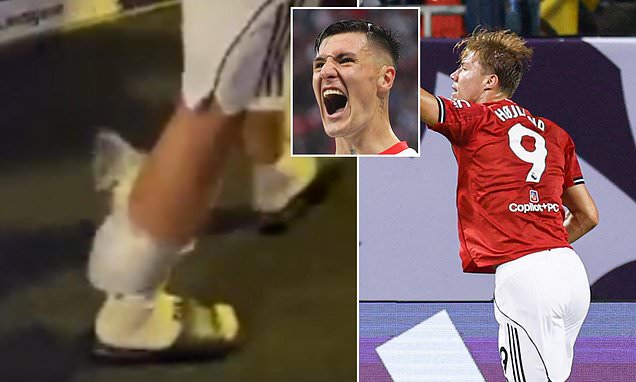The recent pre-season fixture presented Manchester United with a compelling victory over Bournemouth, yet the post-match scene introduced an element of concern. Star striker Rasmus Hojlund was observed exiting Soldier Field with an an ice pack strapped to his calf, immediately sparking discussions regarding his fitness and the ongoing developments in the club’s pursuit of a new attacking talent. This incident casts a shadow over the immediate future, prompting questions about the depth of the squad as the season approaches.
Hojlund, who had impressively netted the opening goal in the 4-1 triumph, did not appear to be severely hampered, leading many to believe the ice pack was primarily a precautionary measure or for managing post-match tightness. However, the exact nature and severity of the issue remain unconfirmed, highlighting the inherent risks of pre-season football and the delicate balance between competitive preparation and injury prevention. The club’s medical staff will be closely monitoring his condition.
His previous season was fraught with challenges for Manchester United, where he often struggled to maintain peak fitness and form, impacting his consistency. This historical context amplifies the current apprehension, particularly as the club actively seeks to reinforce its frontline. The persistent need for a reliable and prolific goalscorer has driven significant efforts in the transfer market to identify and secure an impactful addition.
Despite the immediate fitness concerns, Hojlund’s performance against Bournemouth provided a promising glimpse into his potential contribution. His decisive goal and influential touches throughout the game showcased an improved understanding with his teammates and hinted at the attacking impetus he can offer. Such displays are crucial for building confidence within the squad and offering tangible evidence of progress, vital for navigating the demanding schedule of the upcoming Premier League campaign.
In parallel, Manchester United’s strategic focus in the transfer market has solidified, with Benjamin Sesko now firmly established as their primary target for the striker role. This decision follows a comprehensive evaluation of various top-tier forwards, including Ollie Watkins, signaling a clear strategic direction from the club’s hierarchy. The Slovenian powerhouse’s profile aligns well with the team’s long-term vision and tactical requirements.
Instrumental in these high-stakes negotiations is Christopher Vivell, Manchester United’s director of recruitment, whose previous tenures at Leipzig and Sesko’s former club, Red Bull Salzburg, provide him with invaluable familiarity with the player. Vivell’s deep understanding of Sesko’s capabilities and market dynamics is expected to be a significant advantage in brokering a deal, as United aims to secure this pivotal signing and strengthen their attacking options for the new season.
The intertwining narratives of Rasmus Hojlund’s fitness setback and the intensified efforts to acquire Benjamin Sesko create a critical juncture for Manchester United. The club’s ability to navigate these challenges will heavily influence their attacking capabilities and overall competitiveness. Ensuring both immediate readiness and long-term strategic reinforcements will be paramount as they prepare for the rigors of top-flight football.
This situation underscores the unpredictable nature of pre-season football and the constant strategic adjustments required at the highest level. The health of key players like Rasmus Hojlund directly impacts tactical planning and transfer urgency, while the pursuit of talents like Benjamin Sesko demonstrates the club’s ambition to build a formidable squad capable of challenging for honors. All eyes will be on Manchester United’s next moves.





Leave a Reply